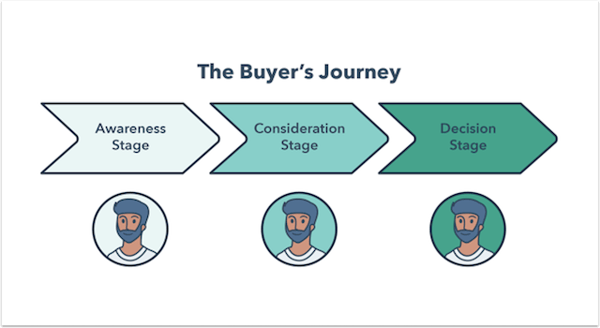Every time you write a blog post, it's one more indexed page on your website — and one more opportunity for you to show up in search engines and drive traffic to your website. In fact, websites with a blog tend to have 434% more indexed pages. That’s a lot of opportunity.

An increase in indexed pages means an opportunity to gain traction with your audience, which is an exciting, rewarding experience. And once you get to this point, you may be asking yourself, “What next? How do I grow in the right direction?”
To start, here’s a video that lists 10 tips to consider if you want to improve your business blogging strategy efforts.
If you’re looking for more prescriptive step-by-step advice, then here are two things to keep in mind as you plan to grow your blog into an integral part of your overall content strategy plan.
1. Optimize Your Content for Conversions
When you’re just starting a blog, your focus is on generating awareness and growing traffic. But once your traffic starts to grow, it’s important to figure out what this audience cares about and responds to.
The goal should be to provide a helpful experience that progresses them through their buyer’s journey. The buyer’s journey is the active research process someone goes through leading up to a purchase.

Each business will have a unique buyer’s journey, designed around their buyer’s problems and needs. It’s a recipe that can’t necessarily be replicated from one business to another.
But don’t expect your audience to understand what their journey is. That’s your job.
If you take the time to create content that attracts your ideal audience, then take the time to identify the buyer’s journey for that audience. Ultimately, they’re looking to you to be informed, so craft a buyer’s journey of helpful assets, whether that be case studies, white papers, guides, free demos—whatever your audience would need on their way to becoming a customer. Knowing these assets will be helpful when creating and optimizing your blog posts so that you can support them accordingly.
Here’s a pro tip to consider: The buyer’s journey for your personas is ever-evolving.
You should always be looking for ways to improve the experience of your personas. For example, is there a blog post that people read most before converting into a lead or customer? Then consider linking that to a relevant top-performing offer. You could also consider updating or improving that content by expanding it into an offer or two like a guide or a live webinar that can double as a recorded video training offer in the future.
Whatever adjustments you make, document them. It’s important that you document what works, what doesn’t, and why. This way, as you grow, you can be making strategically informed decisions based on data and results.
2. Manage Your Content Library
It takes a lot of time to create quality, educational content. And once you have a robust library of content like this in your possession, you can use it to work smarter.
Optimizing your top-performing content that’s still relevant is an effective way to efficiently increase your blog’s performance. For example, check out this lead nurturing workflow blog post from SmartBug Media. This blog post was published on December 2013 and received 115 visits in its first month of being published.

However, over the past 58 months, this blog post received 4,767 visits, which resulted in 230 new leads. And this is just one post…

This blog post had a relevant topic — creating a lead nurturing funnel — that didn’t decay over time. HubSpot analyzed 15,000 companies and found that posts like these that are always of interest to readers account for 38% of total blog traffic across our sample.
Something important to note about this blog post — it was optimized over time. And you know what? I’m sure SmartBug will continue to optimize it based on their goals and how they can best improve the buyer’s journey for their audience consuming the post.
Part of making optimizations to your overall content library is ensuring that the content you do have published on your blog is providing value to your audience. Remember, quality always outweighs quantity.
On the subject of quality content: A top-performing blog prunes content that's underperforming.
Now, I know what you’re thinking. Is Justin about to tell me that I should unpublish underperforming blog content? Because that content took me a lot of time to create. Yes. Not every blog post you publish will be a top performer. And if you don’t manage your content library, then it can actually hurt your website’s SEO in the long run.
For example, Modgility, an inbound growth agency, performed an experiment with one of their customers which resulted in a 158.47% increase in website traffic in four months.

This process started with Modgility being critical about their customer’s blog and website content. Here’s a three-step process Modgility uses when pruning underperforming content:
First, perform a website content audit, including blog and website pages.
Modgility did a content audit for their customer with a six-month date range. They chose this time frame because they do content audits on an ongoing basis.
Second, sort traffic based on unique page views.
Modgility uses Google Analytics, so they were able to export the data into a CSV file. If you have the ability to export your data into an Excel or CSV, then do so. Analyzing everything in a spreadsheet will make the process that much easier.
And third, implement the 80/20 rule on your content in the spreadsheet.
The 80/20 content rule is when you identify which blog posts and site pages account for 80% of your website’s traffic, so you can remove the 20% of underperforming pages.
Here’s how to implement the 80/20 content rule:
To start, determine which of your site pages and blog posts are generating 80% of your website traffic. You can do this by multiplying the unique page views by .8, which will give you the 80% total. For example, let’s say during your six-month content audit, you found that your blog and website received 15,000 unique pageviews. If you multiply that number times .8, it’ll give you the 80% figure you seek, which, in this case, is 12,000.

Next, sort your pages by most unique page views in descending order, and mark which pages account for 80% of website traffic. This is an important step. Make sure you organize and mark everything accordingly so that you correctly weed out the 20% of underperforming pages.
Once you identify the 20% of underperforming site pages and blog posts, remove them from your site. But don’t just unpublish these pages; apply 301 redirects to them to the most relevant page on your website. Now, if you have multiple pages that fall just outside of the 80% group and you believe they could still provide value with an optimization update, then consider keeping them — but only if you’re going to put care and energy into updating them.
One last thing: Don’t get rid of the content you remove from your site. Archive it so that you can access it in the future. This way you can salvage the content by repurposing and combining it when you need it down the road — like scrapbooking together an all-in-one-place comprehensive educational website page.
And as for Modgility’s example, out of the 140 pages they audited, they identified 48 underperforming pages, which they applied 301 redirects to and removed from the site. That’s almost 35% of the content gone — poof. But, remember, this content pruning led to a 158.47% increase in traffic in just four months.
Before doing an audit like this and removing your underperforming content, make sure it’s the right time. Here’s a pro tip: Wait until you have a high amount of blog and site content, like 50 pages, before removing any content from your website.
And there you have it: some sound advice on tips to keep in mind as you grow your blog to the next level. Now it's time for you to transform your blog and website into a revenue-generating machine.
Want to connect with others on HubSpot tips, tricks, and updates? Head over to the HubSpot Community to join a conversation or start one of your own.










